When setting out to make wine from grapes, one of the first major decisions is what you will use as a fermentation container. For most winemaking, you will need a primary fermenter and an aging container. Vessels for both purposes are available in a variety of materials and in many sizes. Frequently used choices include plastic buckets and bins, carboys of glass or plastic, stainless steel tanks and kegs, and the traditional oak barrel.
To match your fermenter choices to exactly your chosen winemaking regime, several factors come into play. First and foremost is simple: volume. How much wine will you make?
Along with considering fermenter size, you will also need to think about whether you will make exclusively red wine (where fruit is included) or also white and rosé wines where juice is fermented without the fruit. While all of these fermenters are safe for wine production, different materials of construction have advantages or disadvantages in some situations. The containers also vary greatly in price, so your winemaking budget becomes a factor as well. Finally, no matter what container you would like to use, it must be available in your area or shipped at a reasonable cost. To simplify this discussion, I will divide fermenters into four broad groups: tubs, jugs, tanks, and barrels.
 Tubs
Tubs
This group includes buckets, food-grade plastic trashcans, and large plastic picking bins. All are made from food-grade plastic resins, most commonly polyethylene or polypropylene. These plastics do not contain the plasticizer Bisphenol A (BPA), which has been shown to exert weak but measurable hormone-like effects in animals. You don’t want that in your wine! To check for certified food grade status, you can look for the seal of the National Sanitation Foundation (NSF) and a recycling code of 1, 4 or 5 at the bottom of the container. Don’t use vessels with recycing code 7 – these contain BPA.
Common fermentation bucket sizes start at 5 gallons (19 L), with 6.5 gallon buckets (25 L) available at every local homebrew supply store. Only slightly less commonly available are the food-grade trashcans, which are manufactured for use in commercial food production as ingredient containers. Sizes include 10 gallons (38 L), 20 gallons (76 L), 32 gallons (121 L), and 44 gallons (167 L). The large picking bins, commonly called half-ton bins, are available in fruit-growing regions, but must be shipped by motor freight if not found locally. They are about four feet by four feet and two feet deep (1.2 m x 1.2 m x 61 cm).
All of these open plastic fermenters are best for primary fermentation of red wine. For that purpose, you need room for the must and the cap. Plan on having about 12 to 15 gallons of capacity for every 100 pounds of crushed grapes (1–1.3 L/kg). You can ferment around 65 lbs. (29 kg) in a 10-gallon (38-L) bucket, over 200 pounds (91 kg) in a 32-gallon (121-L) trashcan, and close to a ton (900 kg) in a half-ton bin. (The half-ton refers to weight of whole clusters when it is used as a harvest bin).
All of these units provide a shallow pool for red wine must, making the cap just a few inches (~7 cm) thick and facilitating punch-down with simple manual tools. If you wish to contain some of the fermentation heat and cut down on fruit fly presence, you can cover the bin with a lid or a sheet of plastic. Unless you can install a tightly fitted lid with a fermentation lock, tubs are not the best choice for white wine fermentation or wine aging. The large surface area at the top exposes the fermenting juice or wine to too much air and risks oxidation.
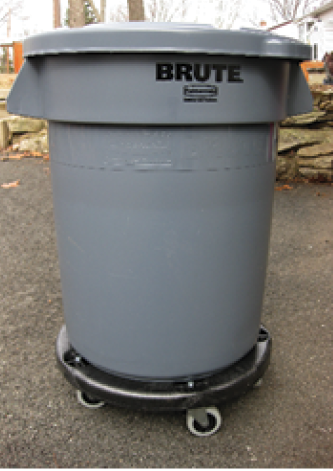
Except for very small trial batches, containers smaller than 20 gallons (76 L) are not very practical for larger scale wine production from fresh grapes. I find the 32-gallon (121-L) size very convenient because the loaded weight of about 200 pounds (91 kg) can be moved around on a concrete cellar floor by two people. The 44-gallon (176-L) size, at over 300 pounds (136 kg), may have to be left where you filled them until pressing day. The half-ton (454-kg) bins can be moved with a forklift, but most of us home winemakers are not lucky enough to have one of those in the cellar! All in all, food-grade plastic tubs in suitable sizes are the top choice for red wine primary fermentation at home.
 Jugs
Jugs
In this group, I place all the narrow-mouth glass and plastic bottle-shaped containers. These include traditional glass 1-gallon (3.8-L) jugs; glass and plastic carboys in 3-gallon (11-L), 5-gallon (19-L), 6-gallon (23-L), and 6.5-gallon (25-L) sizes; and larger glass demijohns in 9-gallon (34-L) and 14-gallon (53-L) sizes. To help offset the handling challenges of the largest glass containers, they are usually covered with a plastic basket equipped with handles.
Glass is a proven material; Mesopotamian containers date back more than 5,000 years. Glass is inert, easy to clean, and provides a complete barrier to oxygen transfer. While reasonably durable in ordinary use, it does have the disadvantage of shattering on impact. Also, clear glass allows light to strike the wine unless the vessel is covered.
Plastic carboys, introduced much more recently, need a bit more care in selection. Those intended specifically for fermentation are made of polyethylene terephthalate or PET. Like the plastics used for food-grade tubs, PET is free of BPA. It is also a reasonably good oxygen barrier, though not as impervious as glass. It is the plastic used in stadium beer bottles and 1.75-L liquor bottles. Steer clear of those blue-tinted water jugs from the hardware store, though. They are usually made of polycarbonate, which does contain BPA and is not suitable for fermented beverages.
The narrow neck of each jug allows the installation of a fermentation lock with a corresponding drilled rubber stopper. Some sizes will also accept waterless silicone breather bungs. As a result, these containers are very useful for white wine fermentation and for wine aging.
For primary fermentation of white or rosé, plan on filling the carboy no more than three-quarters full to allow room for foaming. The relatively small size of carboys and demijohns allows placement in a refrigerator, converted chest freezer or wine cellar for a temperature-controlled fermentation.
For aging, all jugs should be topped up with the same (or compatible) wine to the bottom of the neck. While solid stoppers can be fitted during aging, the use of a breather bung or fermentation lock even during aging allows for thermal expansion without risk of losing the bung — or worse, pressurizing and breaking the bottle.
A gallon jug may be as little as $5, plastic carboys sell for $25 to $35, with glass carboys in each size slightly higher. The large glass demijohns may go as high as $70, but still offer among the lowest per-gallon cost for a glass, stainless steel, or oak wine container. On the whole, jugs make very good white wine fermenters and serve as suitable aging containers for all wines.
 Tanks
Tanks
The most popular tanks for home winemakers are cylindrical stainless steel units fitted with an internal lid. The lid is held in place by an inflatable vinyl gasket, allowing the lid to be secured at any height in the tank. Most of the tanks have a flat bottom with a port low on one side for draining. These tanks need to be placed on a stand or shelf to be drained by gravity.
Some models come with three legs welded in place. Those tanks also generally have a cone-shaped bottom and an additional drain port in the center of it. For either style of tank, sizes vary from 50 L (13 gallons) to 1,000 L (260 gallons). Sizes in the 200- to 400-L (52- to 104-gallons) range are very popular as they overlap with the standard 60-gallon (225-L) oak wine barrel or its commonly available half-size version at 30 gallons (113 L).
Some of the larger tanks have a stainless steel jacket or belt welded around the middle for cooling. A separate glycol chiller unit is connected to ports on the jacket when cooling is desired. Naturally, those tanks are more expensive than the ones without a cooling jacket. For all tanks, prices range from about $300 for smaller tanks to well over $1,000 for larger ones.
The stainless steel material is very inert and fully beverage safe. Cleaning is easy with the lid removed. Below about 800 L (208 gallons), the empty tank is easily moved about by one person and you can just lay it down on the lawn to wash it out. Full, they are not portable and should be left in place where they are filled. You should avoid using bleach when cleaning stainless steel surfaces as pitting can result.
The lid of a variable capacity tank has a port in it suitable for a fermentation lock, so these tanks can be used as closed or open fermenters. With the lid removed, making an open fermenter, the tank’s aspect ratio — the ratio of its height to its width — is a bit tall and thin for red wine punchdowns. The cap can become quite thick and it takes a longer tool to reach well down into the tank,
at least in the larger sizes. The dual-purpose versatility — fermenting and aging — makes up for this inconvenience for some winemakers.
Also made of stainless steel are conventional draft beer kegs or “half barrels.” Although called a half barrel, this is the usual beer keg that you may see at a party or a pub. Its volume is 15.5 gallons (59 L) since the official beer barrel is 31 gallons (117 L). The mechanism in the top of the keg that facilitates dispensing draft beer must be removed to make the keg into a simple tank. This leaves a neck about two inches (5 cm) in diameter making the keg function much like a stainless steel jug. As such, it is suitable for white or rosé primary fermentation and general wine aging. There are special silicone breather bungs made for beer kegs to accommodate the depth the neck, venting during fermentation and sealing for aging. While not as versatile as variable capacity tanks, the lower cost ($50 to $100) may make used kegs appealing. The narrow neck means cleaning is more challenging, so be sure to use a brush to scrub under the top of the keg if you use these. The narrow neck also means kegs are not suitable for a conventional red wine primary fermentation, although they work well if you are using carbonic maceration.
There is sometimes a question of provenance when private parties sell used beer kegs, since they may have been retained by a renter who paid a deposit when buying draft beer but then never returned the keg. The deposit does not cover the cost of the keg and ownership remains with the brewery, unless they sell off used units. Check with your local brewpub, as they sometimes sell kegs that will no longer hold pressure. They cannot use such a keg for beer, but you will remove the pressure mechanism anyway to use it as a tank.
 Barrels
Barrels
Almost aways made of oak (a few are made from chestnut), wine barrels come in sizes from 1 gallon (3.8 L) to 60 gallons (225 L). Oak vessels have been used for hundreds of years for wine storage. Once soaked up for use, they seal well and retain wine very successfully. The narrow bung opening protects the wine from excessive oxidation while the slightly porous wood allows slow and gentle oxygen transport to the wine.
Barrels have the distinction among containers of also providing some wine flavors. Vanilla, toast, and rich sweetness are imparted to the wine by the toasted oak wood. The winemaker can buy a new, used, or reconditioned (recoopered) barrel. The toasting level can be specified, ranging from a pale “light toast” through “medium” to “dark” and even to a very dark “charred”, more suitable for whisky than wine. As the oak contribution of a barrel gets used up over a period of four to six years of use, prices for used barrels drop dramatically. From as much as $1,000 for a new 60 gallon (225 L) French oak barrel, you may pay as little as $50 for an old barrel about to be cut in half to be used for planter tubs. In smaller sizes, new barrels start at about $100, with a new 26-gallon (10-L) American oak barrel commanding close to $400. Recoopered barrels are physically sound barrels that have been played out in terms of oak flavor and aroma contributions. A cooperage removes the head, grinds off the wine-soaked layer of the interior, and re-toasts the barrel. For as little as $300, such a barrel may provide as much as 85% of the oakiness of a new barrel. Smaller recoopered barrels are made from used 60-gallon (225-L) barrels that are disassembled, planed, trimmed, rebuilt, and toasted. They cost from about $300 to $400, depending on size.
As is well known, barrels are good for wine aging. It should be noted, though, that the size has a strong influence on this suitability. As size goes down from the commercial 60-gallon (225-L) barrel, the ratio of oak surface area to wine volume goes up. As a result, a given level of oak flavor contribution will occur faster in a small barrel than a large one.
One useful rule of thumb for new barrels is to allow one week of aging for every gallon of capacity. While this allows over a year for a standard barrel and six months or so for a half-size one, it shows that very small sizes may not be practical. If you age your wine just five weeks in a 5-gallon (19-L) barrel, it may get good oak flavor but it will not be fully aged. You will need another neutral container for that wine to finish it.
In addition to aging finished wine, barrels can be used for fermentation and malolactic fermentation (MLF).
Chardonnay and a few other white wines are often fermented in barrels. Even in a cool cellar, the fermenting juice may get quite warm as the wood provides effective insulation against loss of the heat of fermentation. After fermentation, Chardonnay is sometimes left on the lees in the barrel to help develop better texture and mouthfeel. A barrel used for white wine fermentation remains suitable for aging either white or red wine, although a used red-wine barrel should not be switched to white wine production to avoid color carryover.
If a barrel is neutral, it may still be converted to a red wine fermenter. Stand the barrel on end and use a reciprocating saw to cut out the top. It will be stronger if you leave about two inches (5 cm) of the top all the way around. Drive a bung into the bung hole, and you now have an oak tank suitable for red wine punchdown. Like the variable capacity tanks, the aspect ratio of a barrel is a bit tall, but the presence of an oak surface my contribute positively to tannin and mouthfeel development.
To clean a barrel, let it soak for a few hours or overnight with a solution of sodium percarbonate or sodium carbonate. Rinse out, then rinse with a solution of citric acid to neutralize the alkaline cleaning agent. Now, fill with wine. If the barrel is to be stored for a short time, you can leave it with a sulfite solution bunged up inside. For longer dry storage, burn sulfur sticks or disks in the barrel once every couple of weeks after it has dried.
With barrels, we have wrapped up the major classes of fermenters for home winemakers. There are variations you may run into, but the sizes, shapes, and materials are likely to be familiar after this review. Used shipping drums for foods or beverages will be stainless steel or plastic and shaped like a tank, special-purpose fermenters with a built-in false bottom for vacuum pressing resemble other stainless steel choices, and custom built tanks can be made from many materials (redwood, stainless steel, even concrete), but are out of reach for most of us. It comes down, then, to just a few critical features. Choose your purpose: primary for red wine, primary for white wine, or wine aging. Choose your size in gallons or liters, including issues of portability and shipping costs. Now you can factor in the container shape plus material of construction and you just about have it. After reviewing costs, you will be ready to buy. Now is the season, too. Look at everything out there, make your plans, and get those fermenters. The grapevines have bloomed in wine country and another harvest is on its way!
The Choice
Making a choice between fermenter types can involve considerations of the projected amount of wine to be made (and how that might change in the future), cost, type of wine being made, available space in your winery, safety and perhaps even the chemicals you prefer for cleaning and sanitizing (as different surfaces have preferred cleaners). If you’ve made wine for some time now, you probably have a good idea of what would work in your winery. Choosing the right vessels will make your time spent in the winery more enjoyable. If you are new to winemaking, it pays to check out what local winemakers are doing, especially if they are making the style of wine you will be making and at the same volume. You can’t make a terrible decision in this matter — home winemakers use all these types of fermenters every day. But you can make a decision that gives you more enjoyment of your hobby.
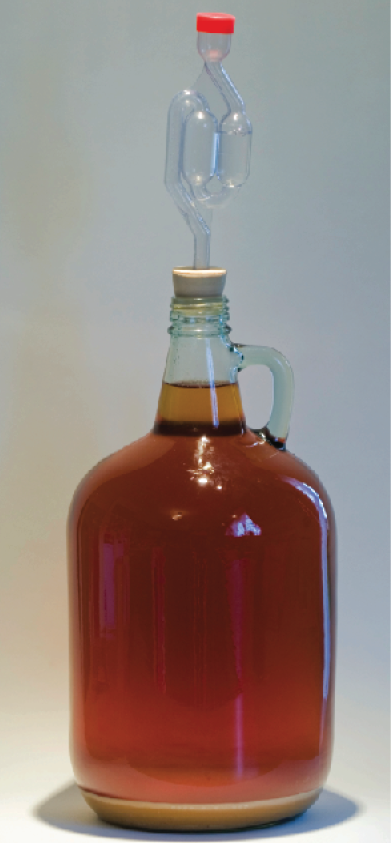
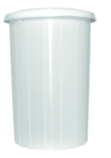 Tubs
Tubs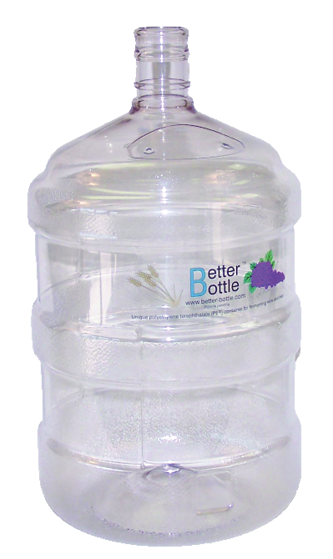 Jugs
Jugs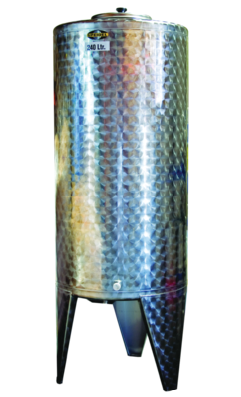 Tanks
Tanks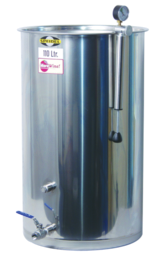
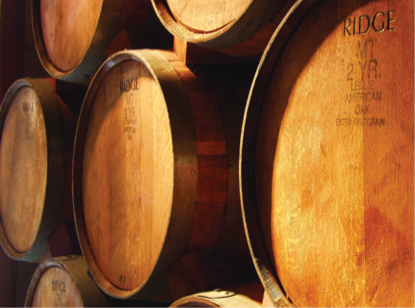 Barrels
Barrels



